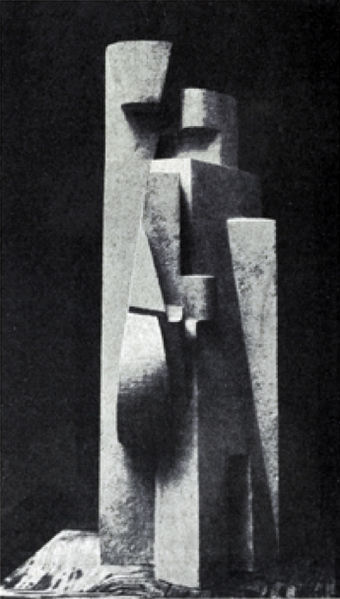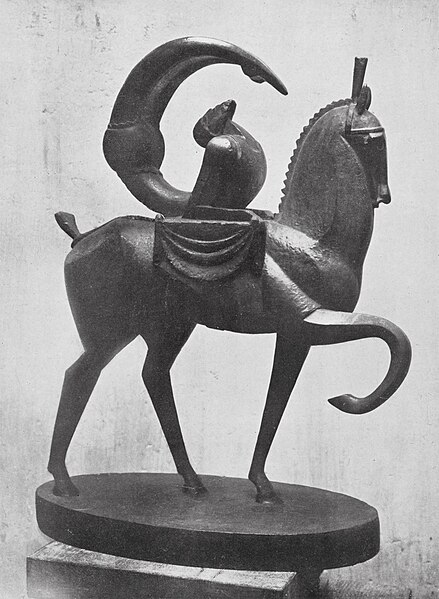Jacques Lipchitz was a Cubist sculptor. Lipchitz retained highly figurative and legible components in his work leading up to 1915–16, after which naturalist and descriptive elements were muted, dominated by a synthetic style of Crystal Cubism. In 1920 Lipchitz held his first solo exhibition, at Léonce Rosenberg's Galerie L'Effort Moderne in Paris where he was counted as part of the School of Paris. Fleeing the Nazis he moved to the US and settled in New York City and eventually Hastings-on-Hudson. While in the US, he created a number of his best-known works, including the outdoor sculptures The Song of the Vowels, Birth of the Muses, and Bellerophon Taming Pegasus, the last of which was completed after his death.
Jacques Lipchitz, 1935, photograph by Rogi André (Rozsa Klein)
Jacques Lipchitz, 1917, L'homme à la mandoline, 80 cm
Amedeo Modigliani, 1916, Jacques and Berthe Lipchitz
Jacques Lipchitz, 1914, Acrobat on Horseback (Acrobate à cheval)
Cubism is an early-20th-century avant-garde art movement begun in Paris that revolutionized painting and sculpture, and inspired artistic movements in music, literature, and architecture. In Cubist works of art, the subjects are analyzed, broken up, and reassembled in an abstract form—instead of depicting objects from a single perspective, the artist depicts the subject from multiple perspectives to represent the subject in a greater context. Cubism has been considered the most influential art movement of the 20th century. The term cubism is broadly associated with a variety of artworks produced in Paris or near Paris (Puteaux) during the 1910s and throughout the 1920s.
Pablo Picasso, 1910, Girl with a Mandolin (Fanny Tellier), oil on canvas, 100.3 × 73.6 cm, Museum of Modern Art, New York
Pablo Picasso, Les Demoiselles d'Avignon, 1907, considered to be a major step towards the founding of the Cubist movement
Albert Gleizes, L'Homme au Balcon, Man on a Balcony (Portrait of Dr. Théo Morinaud), 1912, oil on canvas, 195.6 × 114.9 cm (77 × 45 1/4 in.), Philadelphia Museum of Art. Completed the same year that Albert Gleizes co-authored the book Du "Cubisme" with Jean Metzinger. Exhibited at Salon d'Automne, Paris, 1912, Armory show, New York, Chicago, Boston, 1913.
The "Cubists" Dominate Paris' Fall Salon, The New York Times, October 8, 1911. Picasso's 1908 Seated Woman (Meditation) is reproduced along with a photograph of the artist in his studio (upper left). Metzinger's Baigneuses (1908–09) is reproduced top right. Also reproduced are works by Derain, Matisse, Friesz, Herbin, and a photo of Braque.








